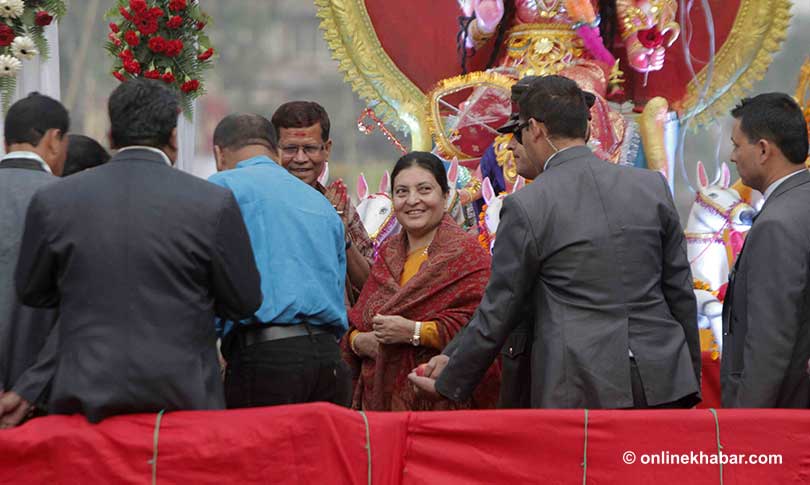Thousands of people gather near water sources in Kathmandu to celebrate the Chhath festival every year. The festival, once exclusively celebrated in the Mithila regions of Nepal and India, has now found its way to the country’s capital, Kathmandu, after many years.
In Kathmandu now, not only do members of the Mithila community celebrate this festival, but many locals from the valley and other immigrants also actively participate in Chhath Puja, worshipping the sun.
Have you ever wondered how this shift occurred? How did a festival specific to a particular community transform into a national celebration? Moreover, how did it journey from Madhes to Kathmandu?
Memories from yesteryear
To understand this, one must delve into the past, going back several decades.
According to Dhirendra Premarshi, a poet and Mithila culture expert, individuals from the Mithila region, residing in Kathmandu, would routinely travel between their village and the Kathmandu valley for various occasions, including festivals like Chhath.
“However, among them, a few people would suggest celebrating the Chhath festival in Kathmandu itself as they were living here,” he says. “After all, it is the festival that needs to be celebrated near water sources. Therefore, people began to gather on the banks of Bagmati, celebrating this festival.”
Mithila artist SC Suman remembers celebrating Chhath on the bank of the Bagmati river near Tripureshwor four decades back. Suman, originally from Siraha and Morang, migrated to Kathmandu four decades ago to pursue a career in fine arts. Since then, he has been celebrating the festival in the capital.
This suggests that the history of Chhath celebration in Kathmandu spans over 40 years, although the exact date of the inaugural celebration remains unknown.

According to Suman, people began migrating to Kathmandu for education and for employment as the opportunities were limited to the capital. Gradually, as their jobs were here, they permanently migrated to Kathmandu, bought properties and houses and also shifted their clan gods and goddesses here.
“Along with people, they shifted their cultural and religious practices,” says Suman.
Premarshi, however, says until around four decades ago, the Chhath celebration in Kathmandu was limited to the individual level. It was much smaller until two decades back.
The first Chhath ghat of Kathmandu
Some families originally belonging to Mithila regions including the families of Dr Gauri Shanskar Lal Das (originally from Dhanusa), Sushil Kumar Sinha (Rautahat), Sachivanand Sriiwastab (Rautahat), Kamal Narayan Das (Dhanusa) among others started observing Chhath puja, as a community, at the Thapathali Ghat for the first time in the Kathmandu valley in 1987, informs advocate Satish Jha, who has been a key person behind the Chhath puja celebration in Kathmandu since 1991.
But, at that time, the celebration would be held at Thapathali ghat only, according to him.
“It was done under the leadership of Terai Bikash Samaj”, mentions Premarshi.
From 1989/90, the then government started constructing a new bridge on the western side there and the area being used for the puja and celebration was occupied. “Then, we started organising the Chhath puja behind the Paropakar Maternity and Women’s Hospital on the bank of Bagmati river,” remembers Jha.
After the people’s movement II (2006), that area was occupied by landless squatters. Since then, people have been organising the Chhath puja on the western bank of the Kupandole Bagmati bridge.
From the festival of Madhes to the festival of all
Before 2006, there was no holiday dedicated to this festival. So, people found it easier to celebrate it in Kathmandu than to travel to their original places, inform all the three. On the other hand, as the country was witnessing a violent conflict between the government and the Maoist rebels, travelling to the southern districts became even more difficult and frightening.
Premashi says, “These bad times brought good changes for the development and promotion of the Chhath festival in Kathmandu. Many started celebrating Chhath in Kathmandu only, just because of the difficulties of going to their hometown in Terai.”

Hence, gradually, people living in different parts of Kathmandu started organising Chhath pujas at different ghats (riverbanks) including at Guhyeshwari in the valley.
But, what brought major limelight to this festival in Kathmandu was the practice of observing Chhath puja in Ranipokhari that started in the early 2010s. After that, locals of Kathmandu, and people from other communities got attracted to this festival, says Premashi.
Initiated from the Thapathali ghat in an organised way over 30 years ago, the Chhath puja celebration in Kathmandu is organised at about 20 ghats in and around the Kathmandu valley. The valley sees around 800,000 people including, including Madhesis and non-Madhesis, during the Chhath puja every year. These are the numbers before the pandemic hit the country, according to Jha.
Today, this festival has become one of the greatest festivals of Kathmandu.
The post The story behind the Chhath festival’s journey from Madhes to Kathmandu, and its expansion appeared first on OnlineKhabar English News.
Comments
Post a Comment